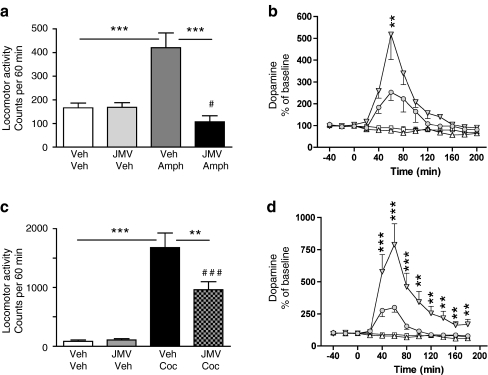Fig. 1.
Suppressed ghrelin signaling by ghrelin receptor (GHS-R1A) antagonist (JMV2959) attenuates amphetamine, and cocaine-induced locomotor stimulation and accumbal dopamine release. a Amphetamine-induced locomotor stimulation was attenuated by a single i.p. injection of JMV2959, but not by vehicle injection in mice (n = 8 in each group; ***P < 0.001, # P = n.s for Veh-Veh vs JMV-Amph). b The amphetamine-induced increase in accumbal dopamine release was absent in GHS-R1A antagonist (JMV2959, i.p.), but not in vehicle-treated mice (n = 8 in Veh-Veh (square), Veh-Amph (filled triangle), and JMV-Veh (triangle) groups and n = 9 in JMV-Amph (circle) group). This difference was evident at time interval 60 min (**P < 0.01, Bonferroni post-hoc test). Even though JMV2959 does not completely block the amphetamine-induced accumbal dopamine release, this increase fails to reach statistical significance compared to vehicle treatment. c Cocaine-induced locomotor stimulation was attenuated by a single i.p. injection of JMV2959, but not by vehicle injection in mice (n = 8 in each group). (**P < 0.01, ***P < 0.001, ### P < 0.001 for Veh-Veh vs JMV-Coc). d The cocaine-induced increase in accumbal dopamine release was absent in GHS-R1A antagonist (JMV2959, i.p.), but not in vehicle-treated mice (n = 8 in Veh-Veh (square) and JMV-Veh (triangle) groups, n = 9 in Veh-Coc (filled triangle) and n = 10 in JMV-Coc groups (circle). This difference was evident at time intervals 20–180 min (**P < 0.01, ***P < 0.001). Even though JMV2959 does not completely block the cocaine-induced accumbal dopamine release, this increase fails to reach statistical significance compared to vehicle treatment

